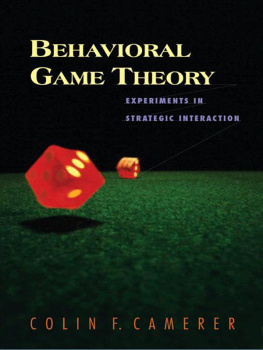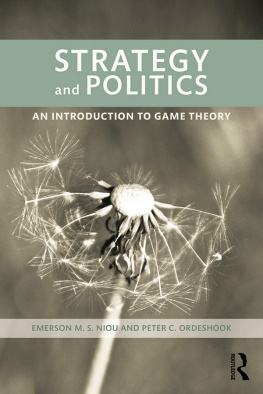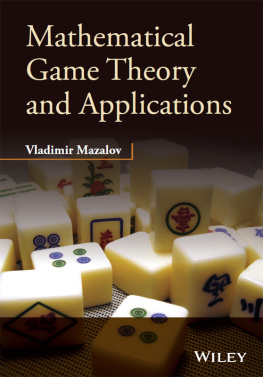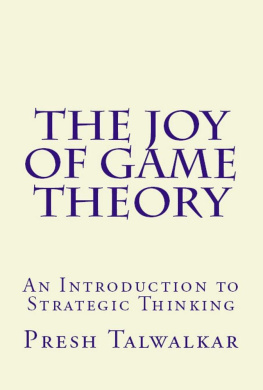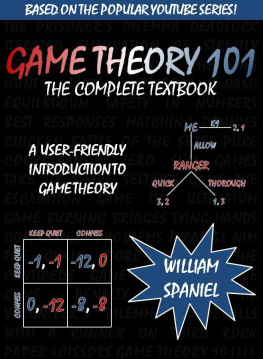Contents
List of Figures
Guide
Pagebreaks of the print version
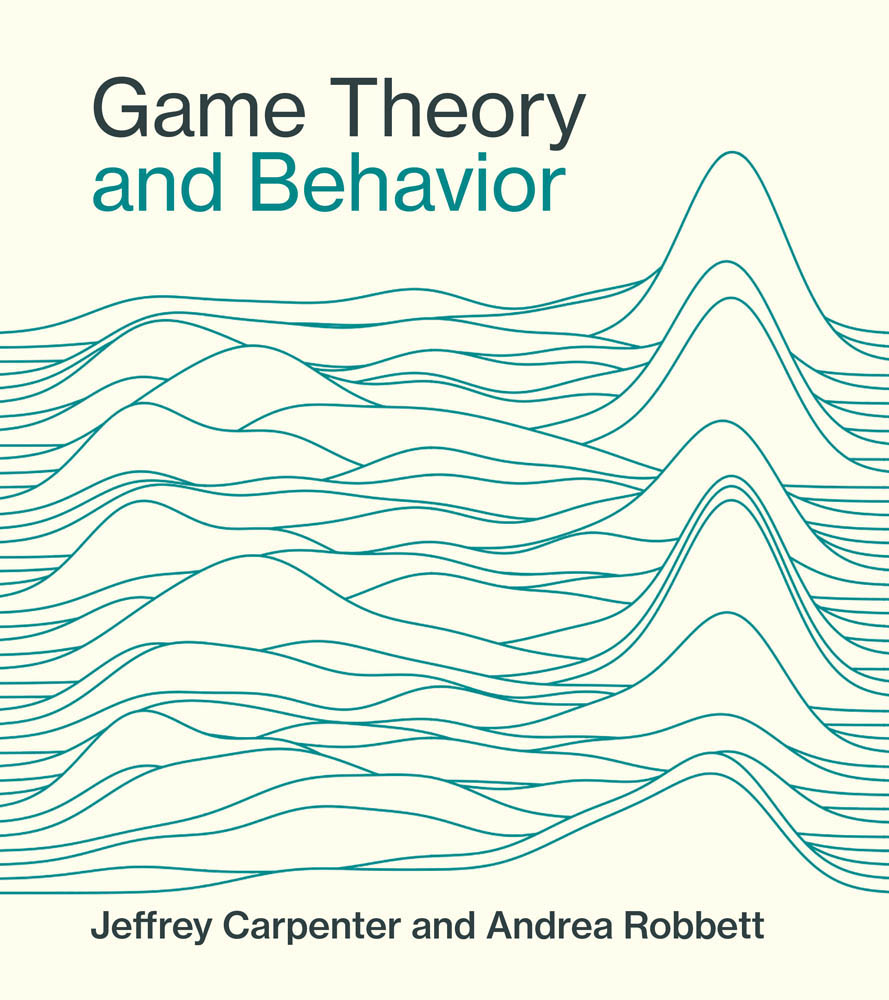
Game Theory and Behavior
Jeffrey Carpenter and Andrea Robbett
The MIT Press
Cambridge, Massachusetts
London, England
2022 Massachusetts Institute of Technology
All rights reserved. No part of this book may be reproduced in any form by any electronic or mechanical means (including photocopying, recording, or information storage and retrieval) without permission in writing from the publisher.
The MIT Press would like to thank the anonymous peer reviewers who provided comments on drafts of this book. The generous work of academic experts is essential for establishing the authority and quality of our publications. We acknowledge with gratitude the contributions of these otherwise uncredited readers.
Library of Congress Cataloging-in-Publication Data
Names: Carpenter, Jeffrey P., author. | Robbett, Andrea, author.
Title: Game theory and behavior / Jeffrey Carpenter, Andrea Robbett.
Description: Cambridge, Massachusetts: The MIT Press, 2022. | Includes bibliographical references and index.
Identifiers: LCCN 2021052788 | ISBN 9780262047296 (hardcover)
Subjects: LCSH: Game theory. | EconomicsPsychological aspects. | Human behavior.
Classification: LCC HB144.C3675 2022 | DDC 519.3dc23/eng/20220128
LC record available at https://lccn.loc.gov/2021052788
d_r0
Contents
List of Figures
Preference ranking and payoffs.
Preference ranking and payoffs when another students choice matters.
The Sally Anne task.
A betting game.
The prisoners dilemma.
A generic prisoners dilemma.
A game in extensive form.
The natural condition game played (a) sequentially and (b) simultaneously.
The extensive form of rock-paper-scissors. Players choose from three actions: (R)ock, (P)aper, and (S)cissors.
The extensive form of the Princess Bride game.
The natural condition game played sequentially.
The natural condition game played simultaneously.
Rock, paper, scissors played simultaneously.
The Princess Bride game.
Two extensive forms consistent with the same normal form.
Game from figure 2.1 in normal form.
Game 1.
Game 2.
Game 1(a).
Game 2(a).
Game 1(b).
Game 3 (the prisoners dilemma).
Shading your bid and plumping your bid are both weakly dominated strategies.
Game 4.
Game 4(a).
Iterated elimination of dominated strategies.
Game 5.
Game 5(a).
Game 5(b).
Game 5(c).
Iterated elimination of dominated strategies in the beauty contest.
Claiming $100 is weakly dominated by claiming $99.
Game 6 (prisoners dilemma in the lab).
Game 6(a) (prisoners dilemma with fairness outcomes).
Beauty contest guesses reported in Bosch-Domnech et al. (2002).
A zero-sum game.
Bernie maximizes his minimum payoff. Cells show Bernies payoff from each outcome.
Hillary minimizes Bernies maximum payoff. Cells show Bernies payoff from each outcome.
Example 1: Minimax solution. Cells give Offenses payoff from each outcome.
Example 2: Minimax solutions.
The Princess Bride game.
A general-sum game.
Player 1s best responses to player 2s strategies (left) and player 2s best responses to player 1s strategies (right).
Both players best responses.
A game with multiple Nash equilibria.
Nash equilibria in the Bernie-Hillary game.
Nash equilibrium in the prisoners dilemma.
Best responses in the Princess Bride game.
The Holmes-Moriarty game.
The Holmes-Moriarty game, assuming that Sherlock chooses Dover with probability p and Moriarty chooses Dover with probability q.
Moriartys expected payoffs from Dover and Canterbury as functions of Sherlocks strategy.
Moriartys best response to Sherlocks mixed strategy p (a), Sherlocks best response to Moriartys mixed strategy q (b), and both overlaid on the same graph with the Nash equilibrium at the intersection (c).
The Princess Bride game.
The stag hunt.
Best response functions in the stag hunt game with the three Nash equilibria at the points of intersection.
Card game example from ONeill (1987).
C is an NBR, but is undominated by A or B.
C is an NBR. While it is undominated by A or B, it is dominated by a mix of the two.
Nash equilibrium predictions and experimental results from ONeill (1987) and Shachat (2002).
Nash equilibrium prediction and experimental data from three games in Goeree and Holt (2001).
Player 2s best response (top left), player 1s best response (top right), and both best responses with the Nash equilibria along the thick line and at black dot (bottom).
Utility is now continuous in the first passengers claim.
Best response functions for the two passengers.
The players best response functions in the Cournot duopoly game with a unique Nash equilibrium at (33, 33).
A symmetric game.
Data from Huck et al. (2004).
Claims in the travelers dilemma.
Treatment differences in the travelers dilemma.
Regret minimization.
Maximum regrets in the travelers dilemma.
The Centipede Game.
Player is payoffs in the minimum effort game for any level of own effort (ei) and minimum effort of others ( e ).
The stag hunt game.
Coordination game between Alice and Bob.
The leave me alone game between Ares and Hera.
Risk dominance and basins of attraction.
A game in which the payoff dominant and risk dominant equilibria overlap.
Pure coordination games.
Stop or go game.
A public traffic signal.
An imperfect public signal.
Payoffs in the minimum effort game from van Huyck et al. (1990).
Three games from Haruvy and Stahl (2004).
The minimum effort game with identity-contingent social preferences.
The Martian game between the Crew (C) and NASA (N).
The Martian game in normal form.
The Martian game equilibria. The thicker black lines show the portion of the strategy profile on the equilibrium path, and the gray lines show the portion that is off the equilibrium path.
The clean your room game.
The clean your room game written in normal form.
Multistep example where payoffs are written for player J(amie), then player A(melia), then player M(att).
The centipede game.
A sequential game with continuous strategies: Starbucks first chooses a price, s, and then Peets chooses a price, p.
A sequential game of imperfect information between players R(ogelio) and X(iomara).
The final subgame.
Stag hunt with a sensitive hunter.
Game with noncredible punishment.
Data from noncredible threat games. Notes: Payoffs are listed for (player 1, player 2) for each outcome. % choosing Risky indicates player 1 choices consistent with SPNE.
Level-k strategies in the centipede game. Note: Each players strategy lists their action in order of the turn to move. P is Pass; T is Take; R is Randomize.
A taxonomy of repeated games.
A stage game with one equilibrium.


